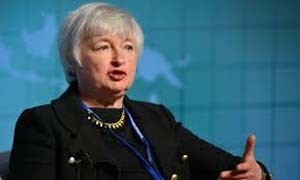Investors are awaiting this week's FOMC Meeting, yet the overwhelming consensus is that the Fed won't raise interest rates.
The U.S. Federal Reserve's two-day meeting kicks off Tuesday. The Fed meeting will conclude with a statement at 2 p.m. on Wednesday. There will not be a press conference after the meeting.
 After the Fed's meeting last month, central bankers left interest rates unchanged near zero. Fed Chairwoman Janet Yellen said that mounting uncertainty over the global economy had overshadowed the progress made here in the United States.
After the Fed's meeting last month, central bankers left interest rates unchanged near zero. Fed Chairwoman Janet Yellen said that mounting uncertainty over the global economy had overshadowed the progress made here in the United States.
While the Fed is expected to once again pause on implementing an interest rate hike, this week's FOMC meeting will still be closely watched. Investors and economists will be looking for any hint of change in the Fed's outlook, as well as an indication if rates will rise before the end of the year.
The Fed's final meeting of 2015 is in December.
Will the December FOMC Meeting Lead to a Rate Hike?
Many economists predict we'll see the first interest rate hike since 2006 following the December FOMC meeting.
Some believe the Federal Reserve will hike rates then because the Fed officials want to begin the journey to "normalization" as soon as possible.
But a March 2016 interest rate hike looks more likely.
The global economy remains the biggest concern for Yellen. Europe, Japan, and China are still in easing monetary mode, and that's problematic for the Federal Reserve.
In the past week, China posted its slowest gross domestic product (GDP) growth since the Great Recession. Japan reported a sharp decline in export growth. And European analysts trimmed their projections for Eurozone inflation.
Last Thursday, European Central Bank President Mario Draghi signaled the bank is prepared to engage in another stimulus package to revive the Eurozone's anemic economy.
Friday, the People's Bank of China cut its benchmark lending and deposit rates by 0.25%. It was the Asian nation's sixth interest rate cut in less than a year.
The Bank of Japan, meanwhile, is expected to increase the pace of its asset purchases (presently $662 billion a year) as early as Friday.
But the Federal Reserve isn't just looking at global problems; there are also signs of a slowing economy stateside...
About a third of S&P 500 components have already reported Q3 earnings, and most have been uninspiring. Now, another 150 S&P 500 companies report Q3 results this week.
Profit and revenue are falling in sync for the first time in six years. Analysts expect the benchmark's companies to book a collective 2.8% decline in per-share earnings from last year's third quarter, according to Thomson Reuters.
Sales are on pace to fall 4%. That will mark the third consecutive quarterly decline. The last time sales and profits fell in the same quarter was in Q3 2009, as companies were reeling from the effects of the financial crisis.
Fed officials have pledged that any rate rise would not come as a surprise to markets. No surprises are expected Wednesday, but a hawkish shift in the Fed's tone could cause some serious aftershocks.
Stay informed on what's going on in the markets by following us on Twitter @moneymorning.
The Global Wealth Gap Is Now Alarmingly Wide: The top 0.7% of people in the world now control more than 45% of the entire world's wealth. But it's not just the lower class that's suffering. The global middle class is controlling less and less wealth every year...
Related Articles:


